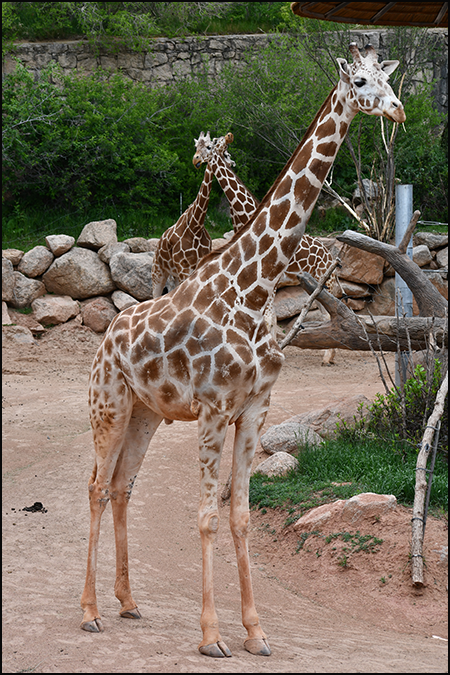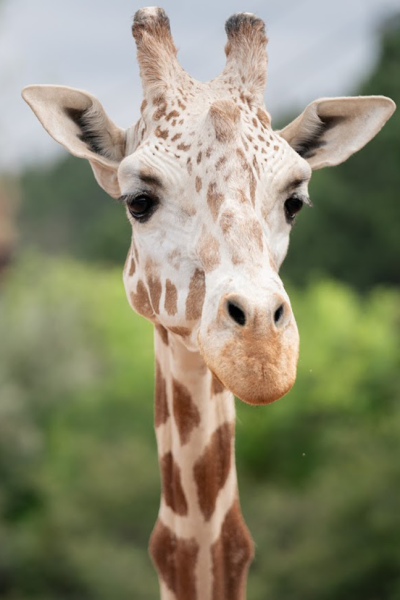HE WAS THE SECOND-OLDEST MALE GIRAFFE IN HUMAN CARE IN THE COUNTRY WHEN HE PASSED – Cheyenne Mountain Zoo staff and giraffe fans are reflecting on the life of a legendary giraffe, Mahali [ma-HAUL-ee]. After an age-related decline in his health, Mahali’s care team made the difficult but compassionate decision to euthanize him on Thurs., April 10. Mahali was the second-oldest male reticulated giraffe in Association of Zoos and Aquariums facilities in the country at 22 years old.

Mahali’s team remembers him as self-assured and particular, and they’re most grateful for what he taught them. Later in life, Mahali experienced foot and leg issues that affected his mobility. In 2017 and 2020, Mahali went under anesthesia to receive treatments, and those procedures helped him heal and return to a good quality of life. In 2023, his care team decided to avoid future risky anesthesia, and focus on helping Mahali live well as an old giraffe by making environmental accommodations for him.
“Mahali changed the way we think about caring for aging giraffe,” Rick Hester, CMZoo animal behaviors curator, says. “It’s not often you have the opportunity to work with a male giraffe this old, and once we understood each other, we could try all sorts of accommodations to help him age comfortably.”
Mahali advanced giraffe care by allowing his team to glue orthopedic shoes to his hooves, and by helping his team understand quality-of-life measurements that made sense for him as an old giraffe, as opposed to a young giraffe. A good quality of life for an aging giraffe includes having comfortable places to rest, participating in husbandry training, socializing with giraffe friends, eating well, being able to lie down and stand up, and traversing all terrains.
When keepers noticed Mahali was ‘saying no’ to training consistently around 2017, Amy Schilz, senior animal behaviorist at the International Center for the Care and Conservation of Giraffe at CMZoo, asked Rick to put his decade of animal training experience to the test with Mahali. After Mahali developed a communicative and trusting relationship with Rick, it was game on.
Even in a busy barn, Rick could call out, ‘Hey, Mahali,’ in a low monotone voice. Mahali’s eyes would sharpen focus, his ears would perk up, and he’d start scanning the crowd. Once he spotted Rick, he’d walk right over. Rick and Amy worked consistently together with Mahali’s training, and Mahali learned to trust that he was in control with these humans, who were going to notice his subtle communication cues.

“Mahali had special needs, and what worked for the rest of the herd wasn’t working for him as he aged, so we worked to find the right nuance for Mahali,” Rick says. “When we were together, we were really focused on each other, and Mahali responded well for many years.”
Rick and Mahali stayed focused on each other for Mahali’s remaining years, perfecting the animal-human communication that all CMZoo animal trainers strive for, to provide excellent cooperative care for an animal. Thanks to his dedicated team, Mahali got many more years of quality health, and giraffe fans got many more years of Mahali.
“Mahali was a rascal in his younger years,” Amy says. Amy worked with Mahali for 12 years. “Some might remember we used to sell lettuce for giraffe feedings near the railing of the giraffe yard. We moved it because Mahali could reach over the railing, and he kept nudging staff to give him lettuce, like, ‘Hey, I see what you have there.’”
As Mahali grew up, his confidence was on full display. His team described him as ‘tactile.’ He was known for pulling on keepers’ shirts or pushing other giraffe out of his way to be the center of keepers’ attention. If Mahali didn’t want to move, he wasn’t moving. At the end of the day, when keepers welcomed giraffe to the barn from the yard, he would sometimes opt for a few more hours outside.
“He had a great last day,” Jason Bredahl, CMZoo curator of animal environments and former giraffe animal care manager, says. Jason was present for Mahali’s entire life. “He went out into the yard with an enthusiasm we hadn’t seen in a few days. He soaked up the sunshine and ate lettuce and tree branches while socializing with his herd and our guests. We’re proud of the ‘bonus years’ we’ve been able to give Mahali, and we’re grateful for all the guests he has inspired and animal welfare he has taught us. It’s always hard when we know it’s time to say goodbye, but it’s also our final act of compassion and stewardship for our animals.”
Mahali was the first giraffe calf born in the current giraffe barn, hours before Mother’s Day in May 2003. As the Zoo makes progress on its giraffe habitat expansion and a new 12,000 square-foot giraffe building, giraffe staff say they will take the lessons Mahali taught them to their new giraffe center, and share with keepers around the world through the International Center for the Care and Conservation of Giraffe’s workshops, information sharing and consultations. His legacy will live on in every giraffe that gets to live old well.
About Cheyenne Mountain Zoo
Cheyenne Mountain Zoological Society was founded in 1926. Today, Cheyenne Mountain Zoo, America’s mountain Zoo, offers comprehensive education programs, exciting conservation efforts and truly fantastic animal experiences. In 2025, Cheyenne Mountain Zoo was voted #2 Best Zoo in North America and CMZoo’s Rocky Mountain Wild was named #2 Best Zoo Exhibit in North America by USA TODAY 10Best Readers’ Choice Awards. It is Cheyenne Mountain Zoo’s goal to help guests fall in love with animals and nature, and take action to protect them. Since 2008, CMZoo’s Quarters for Conservation program has raised more than $5 million dedicated to frontline conservation efforts around the world. Of the 237 zoos and aquariums accredited by the Association of Zoos and Aquariums (AZA), Cheyenne Mountain Zoo is one of just a few operating without tax support. Cheyenne Mountain Zoo depends on admissions, membership dues, special event attendance and donations for funding.

